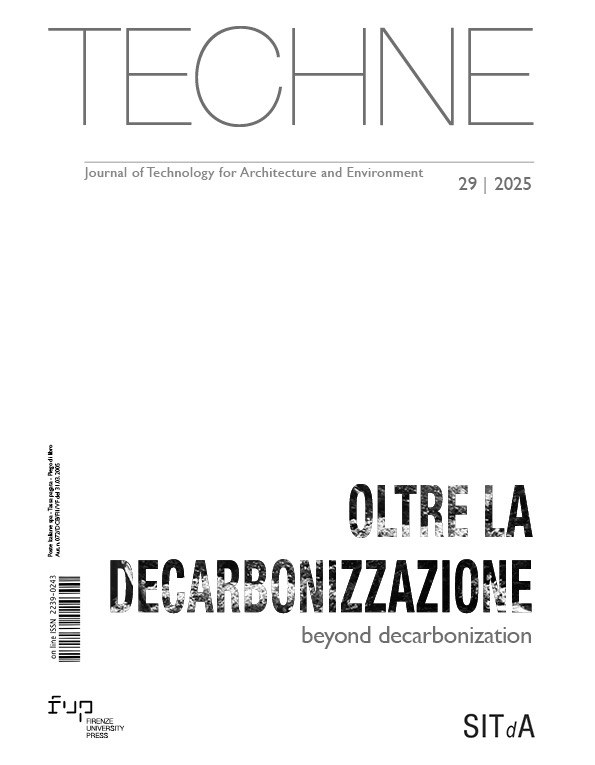Published 2025-07-31
Keywords
- Façade retrofit,
- Textile membranes,
- Energy efficiency,
- Ecological transition,
- Construction resilience
How to Cite
Copyright (c) 2025 Giulia Procaccini

This work is licensed under a Creative Commons Attribution 4.0 International License.
Abstract
Membranes have always played an essential role within the construction sector as a result of their intrinsic properties. Nowadays, with the urgent need to renovate the European building stock, the innovative use of these materials in façade retrofit solutions emerges as a promising strategy to increase the renovation rate. This paper outlines the results of a PhD research that explores Textile Façade Retrofit Strategies (TFRS) as viable, sustainable alternatives to traditional façade retrofits, comparing their environmental and energy impacts. By promoting lightweight solutions, the research aligns with the goals of decarbonisation by significantly reducing the environmental and energy impacts associated with retrofit methods, and enhancing the resilience and adaptability of urban façades.
Downloads
References
- Beccarelli, P. and Chilton, J. (2013), “Advantages of lightweight tensioned coated fabrics and foils façades for the building sector”, Structural Membranes, Proceedings of VI International Conference on Textile Composites and Inflatable Structures, Munich, Germany, 9–11 October, 2013, Universitat Politècnica de Catalunya: Barcelona, Spain, pp. 200-211. Available at: https://upcommons.upc.edu/bitstream/handle/2117/185431/MEMBRANES_2013-18_Advantages%20of%20lighteight%20tensioned.pdf (Accessed on 21/11/2024)
- BPIE (2011), Europe’s Buildings under the Microscope. Available at: https://www.bpie.eu/publication/europes-buildings-under-the-microscope (Accessed on 02/06/2024).
- BPIE (2020), Renovate Europe. Building Renovation, a Kick Starter for the EU Recovery. Available at: https://www.renovate-europe.eu/2020/06/10/building-renovation-a-kick-starter-for-the-eu-economy (Accessed on 02/06/2024).
- Corrêa, D., Flores-Colen, I., Silvestre, J. D., Pedroso, M. and Santos, R. A. (2020), “Old Buildings’ Façades: Fieldwork and Discussion of Thermal Retrofitting Strategies in a Mediterranean Climate”. Designs, Vol. 4 (45), Available at: https://doi.org/10.3390/designs4040045 (Accessed on 22/10/2022) DOI: https://doi.org/10.3390/designs4040045
- Dall’O’, G., Galante, A. and Pasetti, G. (2012), “A methodology for evaluating the potential energy savings of retrofitting residential building stocks”, Sustainable Cities and Societies, Vol. 4, pp. 12–21. Available at: https://doi.org/10.1016/j.scs.2012.01.004 DOI: https://doi.org/10.1016/j.scs.2012.01.004
- Denz, P., Sauer, C., Waldhor, E.F., Schneider, M., and Vongsingha, P. (2021), “Smart Textile Sun Shading. Development of Functional ADAPTEX Prototypes”. J. Façade Des. Eng. 2021, Vol. 9 (1), pp. 101 – 116, Available at: https://doi:10.7480/jfde.2021.1.5539 (Accessed on 26/05/2021)
- European Commission (2020), Energy Efficiency in Buildings, 17 February. Available at: https://ec.europa.eu/info/news/focus-energy-efficiency-buildings-2020-lut-17_en (Accessed on 02/06/2024).
- Konstantinou, T. (2014), “Façade Refurbishment Toolbox. Supporting the Design of Residential Energy Upgrades”, PhD Thesis, Faculty of Architecture and the Built Environment, TU Delft, Delft, Netherlands. DOI: https://doi.org/10.59490/ABE.2014.9.660
- Martinez, A., Patterson, M., Carlson, A. and Noble, D. (2015), “Fundamentals in Façade Retrofit Practice”, International Conference on Sustainable Design, Engineering and Construction, Procedia Engineering, Vol. 118, pp. 934–941. Available at: https://doi.org/10.1016/j.proeng.2015.08.534 (Accessed on 13/02/2022). DOI: https://doi.org/10.1016/j.proeng.2015.08.534
- Mendonça, P. (2010), “Low-span lightweight membranes in housing–environmental and structural potentialities”, in Structures and Architecture, pp. 1–10. Available at: https://repositorium.sdum.uminho.pt/bitstream/1822/12084/1/PM_paperCD.pdf (Accessed on 16/01/2021).
- Monticelli, C. (2015), “Membrane claddings in architecture”, in de Llorens, J.I. (Ed.), Fabric structures in Architecture, Elsevier Ltd., Cambridge, pp. 449-479. Available at: https://doi.org/10.1016/B978-1-78242-233-4.00014-0 (Accessed on 07/03/2021). DOI: https://doi.org/10.1016/B978-1-78242-233-4.00014-0
- Monticelli, C. and Zanelli, A. (2016), “Life Cycle Design and efficiency principles for membrane architecture: towards a new set of eco-design strategies”, Procedia Engineering, Vol. 155, pp. 416–425. Available at: https://doi.org/10.1016/j.proeng.2016.08.045 (Accessed on 17/10/2022). DOI: https://doi.org/10.1016/j.proeng.2016.08.045
- Monticelli, C., Zanelli, A. and Campioli, A. (2013), “Life cycle assessment of textile façades, beyond the current cladding system”, TensiNet Symposium Proceedings, Istanbul, pp. 467-476. Available at: https://www.researchgate.net/publication/277236712_Life_cycle_assessment_of_textile_facades_beyond_the_current_cladding_systems (Accessed on 18/04/2022).
- Monticelli, C., Zanelli, A. and Centrulli, M. (2017), “Application and validation of eco-efficiency principles to assess the design of lightweight structures: case studies of ETFE building skins”, in Proceedings of the IASS Annual Symposium 2017 “Interfaces: architecture. engineering. science”, September 25-28, 2017, Hamburg, Germany, Annette Bögle, Manfred Grohmann (Eds.). Available at: https://re.public.polimi.it/retrieve/e0c31c0c-36d7-4599-e053-1705fe0aef77/IASS%202017_ml_10250_1500268214.pdf (Accessed on 16/12/2020).
- Paech, C. (2016), “Structural membranes used in modern building façades”, Procedia Engineering, Vol. 155, pp. 61–70. Available at: https://doi.org/10.1016/j.proeng.2016.08.007 (Accessed on 12/12/2020). DOI: https://doi.org/10.1016/j.proeng.2016.08.007
- Procaccini, G. and Monticelli, C. (2024), “The application and potentialities of textile façade retrofit strategies for energy-efficient and resilient buildings”, E3S Web of Conferences, Vol. 546, 03005. Available at: https://doi.org/10.1051/e3sconf/202454603005 (Accessed on 20/09/2024). DOI: https://doi.org/10.1051/e3sconf/202454603005
- Procaccini, G., Prieto, A., Knaack, U., Monticelli, C. and Konstantinou, T. (2024), “Textile Membrane for Façade Retrofitting: Exploring Fabric Potentialities for the Development of Innovative Strategies”, Buildings, Vol. 14, p. 86. Available at: https://doi.org/10.3390/buildings14010086 (Accessed on 10/01/2024). DOI: https://doi.org/10.3390/buildings14010086
- Sandin, G. and Peters, G.M. (2018), “Environmental impact of textile reuse and recycling – A review”, Journal of Cleaner Production. Available at: https://doi.org/10.1016/j.jclepro.2018.02.266 (Accessed on 13/02/2023). DOI: https://doi.org/10.1016/j.jclepro.2018.02.266






